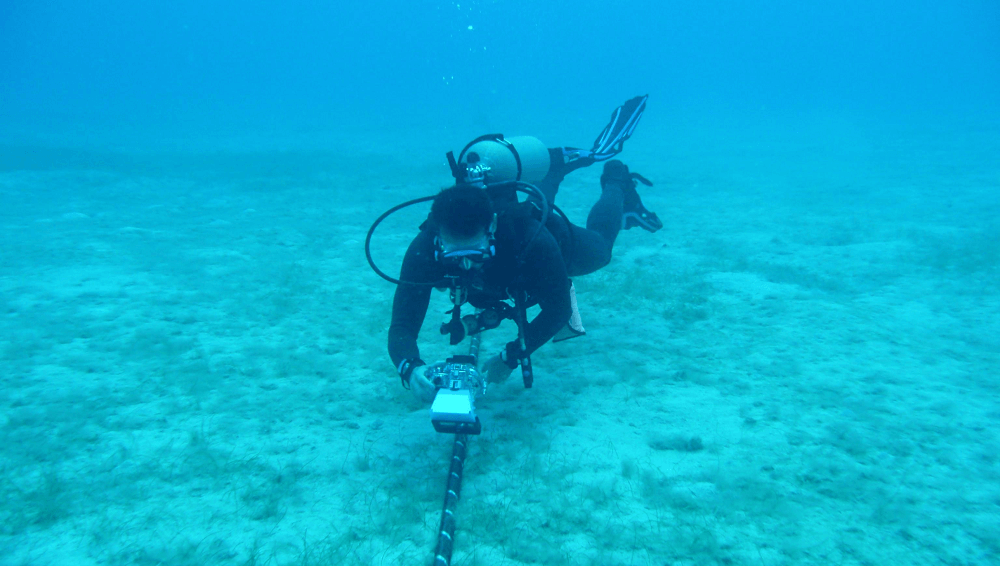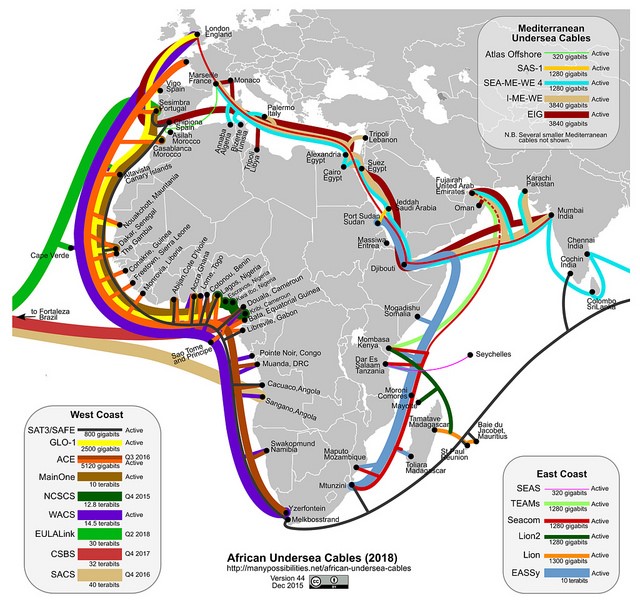Marea 160 Terabit Transatlantic Cable Finished
Three companies - Microsoft, Facebook and Telxius - have jointly laid fiber-optic cable called Marea across the Atlantic Ocean: from US Virginia to Spanish Bilbao. Marea throughput is 160 Tbps. This is the highest performance transatlantic cable to date.
The cable length is 6,600 kilometers, and the average depth is 3.35 kilometers. Marea was laid in less than two years, while the standard term for such projects is about five years. / Flickr / Ministerio TIC Colombia / CC The first wire people laid across the ocean was the transatlantic telegraph cable

. The first attempt was made in 1857, but the cable broke.
On August 5, 1858, a cable was laid between the islands of Valentia and Newfoundland, but already in September it was out of order. Long-term communication between Europe and America was provided only by a cable laid in 1866.
The first telephone cable across the Atlantic appeared in 1956, although it was discussed back in the 1920s. Since then, mankind has paved a huge number of underwater communication channels. They didn’t reach only Antarctica, they access the Internet through satellite communications.

/ Flickr / Steve Song / CC
In 2016, a group of companies, including Google, finished laying FASTER cables from the US to Japan. It can transmit up to 60 Tbits of data per second - at the time of launch it was the fastest .
Formally, FASTER remains the fastest cable and now - they will not start using Marea only at the beginning of 2018. He will reveal his full potential in 2025. By this time, global traffic consumption is expected to grow eight times.
In conditions of such growth , Microsoft and Facebook need a new cable to ensure the stable operation of their services. Microsoft CEO Brad Smith has already spoken About the importance of Marea:
Another reason companies initiated the project was natural disasters. In 2006, a seven-magnitude earthquake occurred on the island of Taiwan, which damaged eight cables connecting the island to China. To restore them, it took 11 ships and 49 days. And Hurricane Sandy in 2012 left unconnected the US East Coast. From that moment, Microsoft decided to increase the resiliency of the transatlantic connections. It turns out that it was Sandy who combined Facebook and Microsoft.
Marea consists of eight pairs of fiber optic cables protected by copper, plastic and a waterproof coating. For most of the way, the cable lies at the bottom of the ocean, and near the shores it is buried underground so that ships will not tear it. So it was in 2012, then over the course of a month two different vessels damaged the cable connecting East Africa with the Middle East and Europe.
The community understands that submarine cables are not without flaws, so they are developing alternative connection methods. Mark Zuckerberg proposes the use of drones, AT&T - electric networks, and some scientists - quantum teleportation. However, these projects are in the early stages of their development or exist so far only on paper.
PS Our digests on Habré:
PPS What else are we writing in our corporate blog:
The cable length is 6,600 kilometers, and the average depth is 3.35 kilometers. Marea was laid in less than two years, while the standard term for such projects is about five years. / Flickr / Ministerio TIC Colombia / CC The first wire people laid across the ocean was the transatlantic telegraph cable

. The first attempt was made in 1857, but the cable broke.
On August 5, 1858, a cable was laid between the islands of Valentia and Newfoundland, but already in September it was out of order. Long-term communication between Europe and America was provided only by a cable laid in 1866.
The first telephone cable across the Atlantic appeared in 1956, although it was discussed back in the 1920s. Since then, mankind has paved a huge number of underwater communication channels. They didn’t reach only Antarctica, they access the Internet through satellite communications.

/ Flickr / Steve Song / CC
In 2016, a group of companies, including Google, finished laying FASTER cables from the US to Japan. It can transmit up to 60 Tbits of data per second - at the time of launch it was the fastest .
Formally, FASTER remains the fastest cable and now - they will not start using Marea only at the beginning of 2018. He will reveal his full potential in 2025. By this time, global traffic consumption is expected to grow eight times.
In conditions of such growth , Microsoft and Facebook need a new cable to ensure the stable operation of their services. Microsoft CEO Brad Smith has already spoken About the importance of Marea:
“Marea was laid on time. 55% more data passes through transatlantic cables than through Pacific cables. And 40% more than cables connecting the USA and Latin America.
Of course, the flow of data across the Atlantic Ocean will grow, and Marea will provide the necessary connection quality for the USA, Spain and other countries. ”
Another reason companies initiated the project was natural disasters. In 2006, a seven-magnitude earthquake occurred on the island of Taiwan, which damaged eight cables connecting the island to China. To restore them, it took 11 ships and 49 days. And Hurricane Sandy in 2012 left unconnected the US East Coast. From that moment, Microsoft decided to increase the resiliency of the transatlantic connections. It turns out that it was Sandy who combined Facebook and Microsoft.
“We constantly met with Facebook representatives at various events and realized that we were trying to solve the same problem. So we teamed up and improved the transatlantic network by designing a new cable, ” said Frank Ray, Head of Cloud Infrastructure.
Marea consists of eight pairs of fiber optic cables protected by copper, plastic and a waterproof coating. For most of the way, the cable lies at the bottom of the ocean, and near the shores it is buried underground so that ships will not tear it. So it was in 2012, then over the course of a month two different vessels damaged the cable connecting East Africa with the Middle East and Europe.
The community understands that submarine cables are not without flaws, so they are developing alternative connection methods. Mark Zuckerberg proposes the use of drones, AT&T - electric networks, and some scientists - quantum teleportation. However, these projects are in the early stages of their development or exist so far only on paper.
PS Our digests on Habré:
- 17 independent blogs in mathematics, algorithms and programming languages
- 15 code structuring materials for developers
PPS What else are we writing in our corporate blog:
